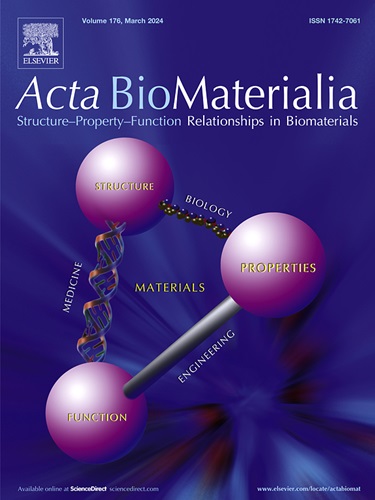THP-1 巨噬细胞和金黄色葡萄球菌在具有明确地形和润湿性的各种钛植入物表面的竞赛。
IF 9.4
1区 医学
Q1 ENGINEERING, BIOMEDICAL
引用次数: 0
摘要
Gristina 等人(1987 年)认为,生物材料的命运是由病原体和宿主之间的 "表面竞赛 "决定的。为了更深入地了解这一概念背后的机制,我们研究了 THP-1 巨噬细胞和金黄色葡萄球菌(1:1 比例)在三种共培养情况下的 "表面竞赛",并改变了添加顺序:(i) 同时添加,(ii) 巨噬细胞先添加,(iii) 金黄色葡萄球菌先添加,在六种经特定形貌和润湿性修饰的 Ti6Al4V-ELI 表面上进行。表面竞赛的结果不受这些生物材料的影响,而受巨噬细胞和金黄色葡萄球菌引入时间的影响。当巨噬细胞和金黄色葡萄球菌同时到达时,巨噬细胞赢得了比赛,通过快速吞噬和杀灭,使存活的金黄色葡萄球菌数量最少。当巨噬细胞首先到达并形成时,巨噬细胞仍占优势,但由于粘附的巨噬细胞杀灭细菌的效率较低,且细胞内有大量存活细菌,因此面临更大的挑战,这支持了所谓的植入物周围免疫受损区的概念(TLR-2 受体和促炎 IL-1β 上调)。当金黄色葡萄球菌首先到达并建立生物膜时,细菌赢得了比赛,导致巨噬细胞功能障碍和细胞死亡(FcγR 和 TLR-2 受体上调、NF-κB 信号传导、NOX2 介导的活性氧),促成了持续的生物膜表型(clfA、icaA、sarA 上调,agrA、hld、lukAB 下调)和金黄色葡萄球菌的细胞内存活(lipA 上调)。其临床意义在于植入物的细菌定植和假体周围组织的细胞内细菌存活,这可能会导致感染慢性化。意义说明:Gristina 等人(1987 年)认为,生物材料的命运是由细菌病原体和宿主细胞之间的 "表面竞赛 "决定的。目前还缺乏体外共培养模型和关于巨噬细胞-金黄色葡萄球菌在生物材料表面相互作用的知识,也没有对金黄色葡萄球菌生物膜中毒力因子的表达进行评估。我们成功开发了共培养模型和分子面板,并阐明了巨噬细胞和金黄色葡萄球菌在多种具有明确表面形貌和润湿性的钛生物材料上的重要细胞和分子相互作用。我们的研究结果强调了生物膜的形成以及细菌或巨噬细胞到达的时间顺序在决定表面命运方面的关键作用。本文章由计算机程序翻译,如有差异,请以英文原文为准。

Race for the surface between THP-1 macrophages and Staphylococcus aureus on various titanium implants with well-defined topography and wettability
Gristina et al. (1987) suggested that the fate of a biomaterial is decided in a “race for the surface” between pathogens and the host. To gain deeper insight into the mechanisms behind this concept, we investigated the “race for the surface” across three co-culture scenarios with THP-1 macrophages and Staphylococcus aureus (1:1 ratio), varying the order of addition: (i) simultaneous, (ii) macrophages first, and (iii) S. aureus first, on six Ti6Al4V-ELI surfaces modified with specific topographies and wettability. The outcome of the race for the surface was not influenced by these biomaterials but by the chronological introduction of macrophages and S. aureus. When macrophages and S. aureus arrived simultaneously, macrophages won the race, leading to the lowest number of viable S. aureus through rapid phagocytosis and killing. When macrophages arrived and established first, macrophages still prevailed but under greater challenge resulting from the lower bacterial killing efficiency of adherent macrophages and numerous viable intracellular bacteria, supporting the concept of the so-called immunocompromised zone around implants (upregulation of TLR-2 receptor and pro-inflammatory IL-1β). When S. aureus arrived first establishing a biofilm, bacteria won the race, leading to macrophage dysfunction and cell death (upregulation of FcγR and TLR-2 receptors, NF-κB signaling, NOX2 mediated reactive oxygen species), contributing to a persistent biofilm phenotype (upregulation of clfA, icaA, sarA, downregulation of agrA, hld, lukAB) and intracellular survival of S. aureus (lipA upregulation). The clinical implications are bacterial colonization of the implant and persistence of intracellular bacteria in periprosthetic tissues, which can lead to infection chronicity.
Statement of Significance
Gristina et al. (1987) suggested that the fate of a biomaterial is decided in a “race for the surface” between bacterial pathogens and host cells. There is a lack of in vitro co-culture models and knowledge on macrophage-S. aureus interactions on biomaterial surfaces, and no studies have evaluated the expression of virulence factors in S. aureus biofilms.
We have successfully developed co-culture models and molecular panels, and elucidated important cellular and molecular interactions between macrophages and S. aureus on a broad range of titanium biomaterials with well-defined surface topography and wettability. Our findings highlight the critical role of biofilm formation and the chronological order of bacteria or macrophage arrival in determining the fate of the race for the surface.
求助全文
通过发布文献求助,成功后即可免费获取论文全文。
去求助
来源期刊

Acta Biomaterialia
工程技术-材料科学:生物材料
CiteScore
16.80
自引率
3.10%
发文量
776
审稿时长
30 days
期刊介绍:
Acta Biomaterialia is a monthly peer-reviewed scientific journal published by Elsevier. The journal was established in January 2005. The editor-in-chief is W.R. Wagner (University of Pittsburgh). The journal covers research in biomaterials science, including the interrelationship of biomaterial structure and function from macroscale to nanoscale. Topical coverage includes biomedical and biocompatible materials.
 求助内容:
求助内容: 应助结果提醒方式:
应助结果提醒方式:


